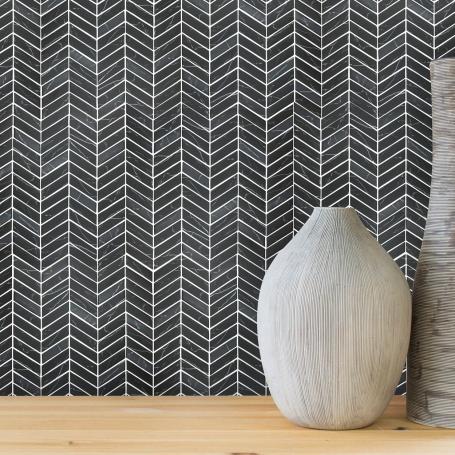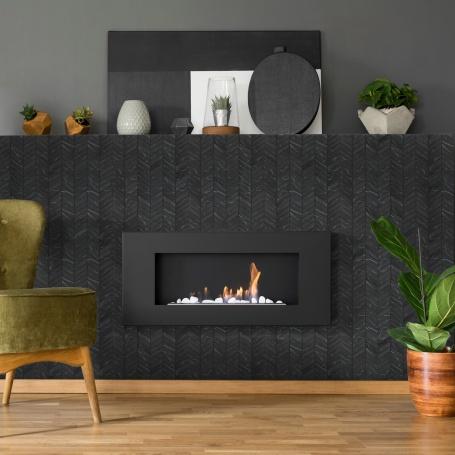
Chevron vs. Herringbone: A Guide to Decorative Tile Patterns
December 12, 2024
Decorative tile patterns have a unique way of transforming spaces, adding texture, depth, and a sense of design flair that few other materials can achieve. Among the most beloved classic patterns in contemporary interior design are the chevron and herringbone. These two styles have stood the test of time and remain staples in modern homes, thanks to their versatility and aesthetic appeal.
While they may look similar at first glance, chevron and herringbone patterns each bring distinct characteristics to a space, making them suited for different purposes and aesthetics. In this post, we’ll explore their differences, explain why they are so popular in interior spaces today, discuss where they work best inside and outside the home and recommend the best types of tiles to try for each pattern.
The Resurgence of Chevron and Herringbone Patterns

Over the years, chevron and herringbone patterns have shifted from being classic staples to trending must-haves. Their enduring popularity stems from their ability to adapt to various interior styles, from traditional to contemporary. Both patterns are celebrated for their visually dynamic effect, which elevates even the simplest tiles to works of art. Here’s why they’re in vogue:
- Timeless Appeal: These patterns have historical roots, having been used in architecture and design for centuries. Their classic nature ensures they never go out of style.
- Versatility: Chevron and herringbone can be applied using tiles in various materials, colors and sizes, making them suitable for almost any space.
- Visual Interest: Both patterns create movement and dimension, drawing the eye and breaking up monotony.
- Customization: With countless tile options available, homeowners can achieve a custom look tailored to their preferences.
Understanding the Differences
At first glance, chevron and herringbone may appear similar, as both feature a zigzag design. However, the differences lie in how the tiles are cut and arranged:
Chevron:
- Chevron tiles are cut at a 45-degree angle to create a continuous v-shaped pattern.
- The ends of the tiles are aligned, creating a clean and seamless zigzag pattern.
- Chevron patterns exude a modern, streamlined aesthetic.
Herringbone:
- The herringbone design uses rectangular tiles arranged in an L-shaped, staggered layout.
- The ends of the rectangular pieces meet to form a broken zigzag or “fishbone” pattern.
- Herringbone has a more traditional and intricate look, often associated with classic parquet flooring.
Where Each Pattern Works Best in Your Home

Both patterns are versatile and can be used in various settings, but certain spaces and applications may suit one pattern better than the other:
Chevron:
- Bathrooms: Chevron works beautifully in smaller rooms and spaces such as shower walls or bathroom floors, where its sleek lines create a spa-like atmosphere. Pair it with neutral tones for a calming effect or bold colors for a striking statement.
- Kitchens: Chevron kitchen backsplash tiles can add a touch of sophistication and modernity, complementing sleek cabinets and countertops.
- Entryways and Hallways: A chevron floor can give the optical illusion of a visually elongated and widened narrow space, creating an inviting entry.
Herringbone:
- Living Areas: The herringbone tile pattern is a favorite for wood or wood-look tiled floors in living rooms, adding a touch of elegance and warmth.
- Kitchens: A herringbone backsplash can bring charm and texture to the heart of the home, particularly in farmhouse or transitional styles.
- Outdoor Spaces: The sturdier visual impact of herringbone flooring makes it a popular choice for patios or pathways, giving an upscale yet durable look.
Types of Tiles Conducive to Chevron Patterns

When choosing tiles for a chevron design, the focus should be on precision and clean lines. Consider the following materials and styles:
- Marble: Marble tiles lend an air of luxury to a staggered zigzag pattern. Choose subtle veining to enhance the pattern without overwhelming the design.
- Porcelain: Durable and easy to maintain, porcelain tiles in chevron patterns are excellent for high-traffic areas. They come in a variety of finishes, from matte to glossy.
- Glass: Glass tiles are perfect for creating a light-reflecting chevron backsplash. They’re available in vibrant colors and metallic finishes for a bold statement.
- Wood-Look Tile: Wood-look porcelain tiles arranged in a chevron pattern mimic the warmth of natural wood while offering greater durability and water resistance as floor tile.
Types of Tiles That Work Best for Herringbone Patterns

Herringbone tiles should emphasize the pattern’s intricate, interlocking design. The following options work well:
- Subway Tiles: Classic subway tiles, especially in white or neutral tones, are a go-to for herringbone backsplashes. Their rectangular shape is ideal for this pattern.
- Natural Stone: Stone tiles like travertine or slate add an organic feel to herringbone layouts, making them perfect for rustic or earthy designs.
- Cement: Cement tiles bring an industrial-chic vibe to herringbone floors or walls. Their muted tones pair well with modern interiors.
- Mosaic Tiles: Smaller mosaic tiles in herringbone patterns create intricate detailing, suitable for accent walls or shower niches.
- Ceramic Tile: Ceramic tiles are another excellent choice for herringbone patterns. Their versatility and availability in a variety of colors and finishes make them ideal for both traditional and contemporary designs.
Tips for Achieving the Perfect Look

- Consider Scale: Larger tiles in chevron or herringbone patterns can make a room feel more expansive, while smaller tiles add intricate detail.
- Mix Materials: Combine different materials or finishes within the pattern to create a unique, layered look.
- Professional Installation: Both patterns require precision, especially chevron. Hiring a professional ensures clean lines and perfect alignment.
- Grout Matters: Choose a grout color that either contrasts with the tiles for a bold effect or matches them for a seamless look.
- Lighting: Proper lighting can enhance the dimensionality of these patterns, highlighting their beauty and texture.
Elevate Your Home with Chevron and Herringbone Patterned Tile
Chevron and herringbone patterns have earned their place in the world of interior design, thanks to their timeless elegance and adaptability. Whether you’re drawn to the sleek precision of chevron or the classic intricacy of herringbone, both patterns offer endless opportunities to personalize your space. By choosing the right materials, colors and applications, you can bring these iconic designs into your home and enjoy their visual appeal for years to come.
So, whether you’re renovating your kitchen, upgrading your bathroom, or adding flair to an outdoor patio, chevron and herringbone patterns are here to elevate your design game. All it takes is a bit of creativity and the right tiles to make these timeless patterns your own.